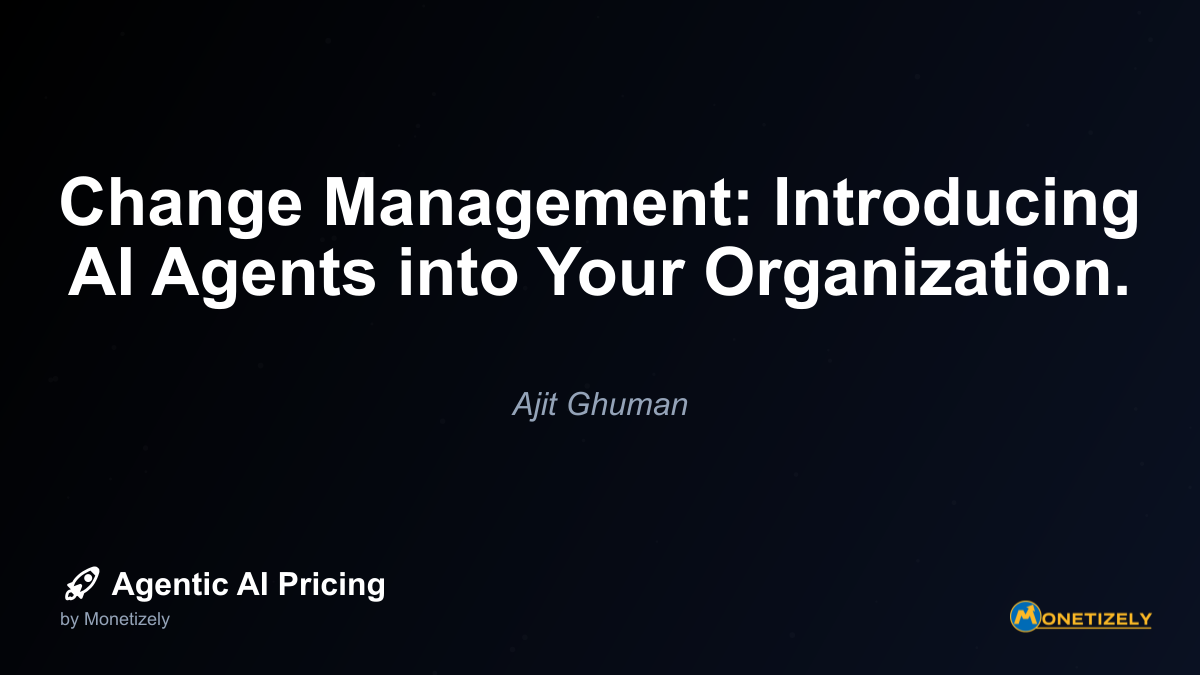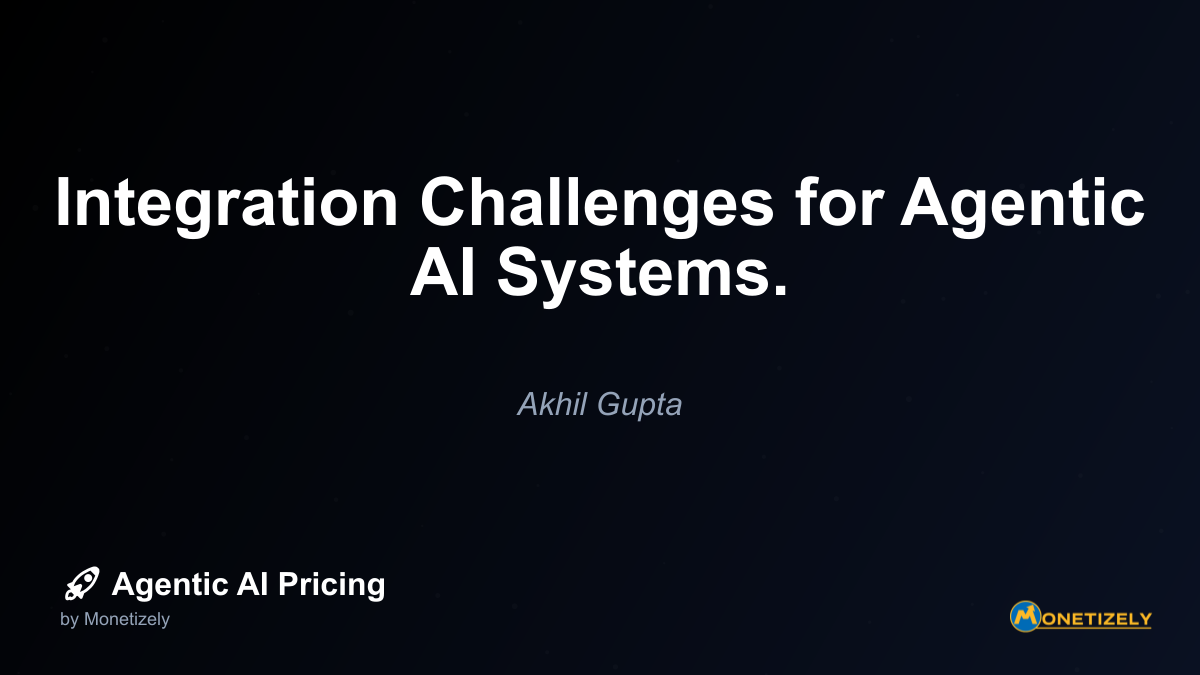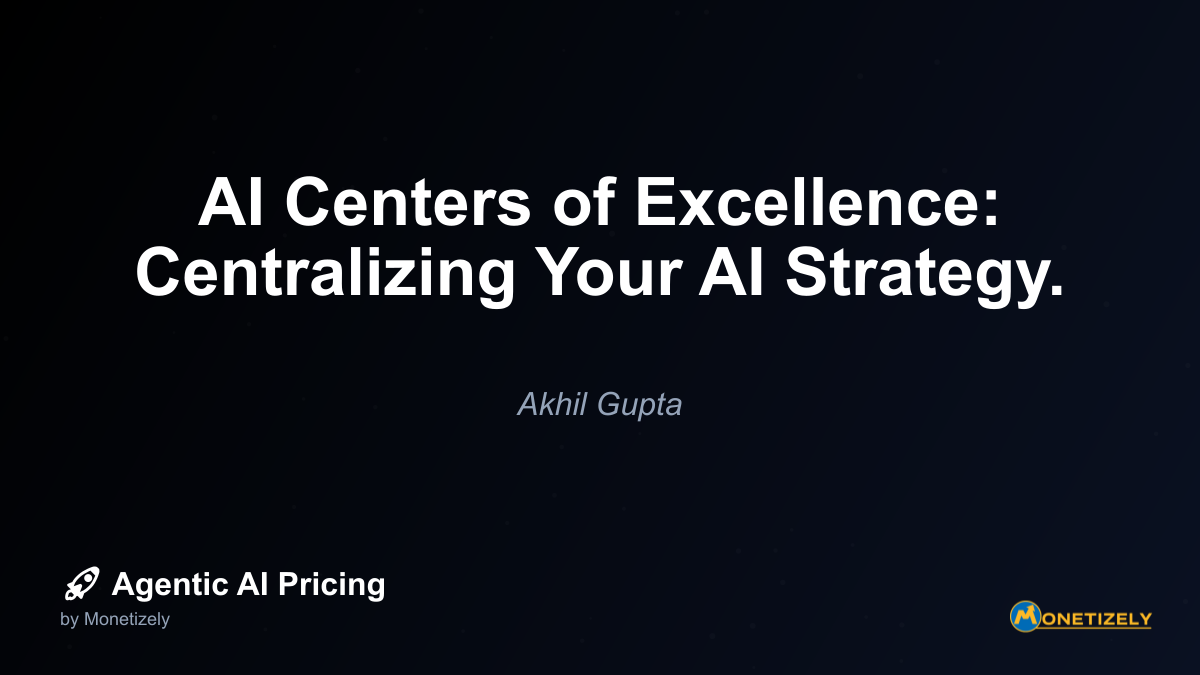· Ajit Ghuman · Implementation Strategies · 10 min read
Leveraging Your Existing Tech Stack for AI Adoption.
AI and SaaS Pricing Masterclass
Learn the art of strategic pricing directly from industry experts. Our comprehensive course provides frameworks and methodologies for optimizing your pricing strategy in the evolving AI landscape. Earn a professional certification that can be imported directly to your LinkedIn profile.

Implementing agentic AI solutions doesn’t have to mean overhauling your entire technology infrastructure. In fact, one of the most efficient paths to AI adoption leverages what you already have in place. By strategically selecting AI tools that complement your existing tech stack, you can significantly reduce integration challenges, minimize disruption, and accelerate your journey toward AI-powered operations.
Why Your Existing Tech Stack Matters for AI Adoption
The technology foundation your business has built over time represents not just significant financial investment but also accumulated operational knowledge, established workflows, and employee familiarity. This existing infrastructure provides a natural starting point for AI implementation.
According to recent industry research, organizations that build AI initiatives on top of their current tech stack see deployment times 40% faster than those attempting complete technological overhauls. This approach also typically results in 35% lower implementation costs and substantially higher adoption rates among end users.
For pricing strategists and product managers specifically, leveraging existing systems means you can more quickly experiment with AI-enhanced pricing models without disrupting your core revenue operations. This creates a safer environment for innovation while maintaining business continuity.
Assessing Your Current Technology Landscape
Before diving into AI adoption, it’s essential to conduct a thorough inventory of your existing technology assets. This assessment should include:
Core Systems Evaluation
Begin by mapping your primary business systems and understanding their capabilities:
- CRM platforms: Modern CRM systems from vendors like Salesforce, HubSpot, or Microsoft often have built-in AI capabilities or ready-made integration points.
- ERP systems: Your enterprise resource planning software likely contains valuable operational data that can fuel AI models.
- Marketing automation: These platforms frequently offer AI-powered features for customer segmentation and campaign optimization.
- Data warehousing solutions: Existing data repositories provide the foundation for AI-driven insights.
Integration Architecture Review
Examine how your systems currently connect:
- API infrastructure: Document existing APIs and integration frameworks that can be leveraged for AI solutions.
- Data flow mapping: Understand how information moves between systems to identify potential AI insertion points.
- Middleware solutions: Existing integration platforms can often be extended to incorporate AI services.
Technical Capability Assessment
Evaluate your organization’s technical readiness:
- Cloud infrastructure: Cloud environments typically offer easier AI integration paths than on-premises systems.
- Data quality and accessibility: AI systems require clean, accessible data to function effectively.
- Development frameworks: Existing development standards can guide how AI components should be built or integrated.
Strategic Approaches to AI Integration Within Your Current Stack
Once you’ve assessed your technological landscape, several approaches can help you leverage existing investments while adding AI capabilities.
The Platform Extension Approach
Many enterprise software providers have recognized the demand for AI functionality and have expanded their offerings accordingly. This presents a natural first option:
Advantages:
- Seamless integration with existing workflows
- Familiar user interfaces reducing training needs
- Unified vendor relationship simplifying support
- Often requires minimal additional infrastructure
Implementation Strategy:
- Inventory AI capabilities already included in your licensed products but potentially unused
- Evaluate platform-specific AI add-ons from your current vendors
- Prioritize extensions that address clear business needs rather than implementing technology for its own sake
Example in Practice: A subscription-based software company already using Salesforce could implement Einstein Analytics for AI-powered pricing insights rather than building a custom solution. This approach leverages existing customer data, familiar interfaces, and established security protocols while adding sophisticated predictive capabilities.
The Bridge Solution Approach
When direct platform extensions aren’t available, specialized AI solutions designed to connect with common enterprise systems offer an effective alternative:
Advantages:
- Purpose-built AI functionality with pre-built connectors to common systems
- Faster implementation than custom development
- Specialized capabilities beyond what general platforms might offer
Implementation Strategy:
- Identify AI solutions specifically designed to integrate with your core systems
- Evaluate connector robustness and maintenance requirements
- Consider data synchronization requirements and potential latency issues
Example in Practice: A B2B service provider might implement a specialized AI pricing optimization tool that connects to both their CRM and billing system through standard APIs. This bridge solution brings advanced capabilities while maintaining data consistency across the existing tech ecosystem.
The Middleware Enhancement Approach
For organizations with complex technology environments, enhancing existing middleware with AI capabilities can provide flexible integration options:
Advantages:
- Centralized AI services accessible to multiple systems
- Consistent implementation across diverse applications
- Ability to evolve AI capabilities independently of end systems
Implementation Strategy:
- Evaluate current integration platforms for AI enhancement opportunities
- Consider API management layers as potential hosts for AI services
- Implement AI functions as discrete services that can be called from multiple systems
Example in Practice: An enterprise with a service-oriented architecture might implement AI-powered pricing recommendation engines as microservices within their existing API gateway. This allows multiple applications to access these capabilities through familiar integration patterns while centralizing the AI functionality for easier management.
Practical Considerations for Tech Stack Integration
While leveraging your existing technology foundation offers significant advantages, several practical considerations should guide your implementation approach.
Data Accessibility and Quality
AI systems are only as good as the data that powers them. When integrating with your current stack, pay special attention to:
- Data silos: Identify where relevant information might be isolated in legacy systems
- Standardization needs: Assess whether data formats and definitions are consistent across systems
- Enrichment requirements: Determine if your existing data requires enhancement to support AI functions
A manufacturing company implementing AI-powered pricing might discover that while they have extensive product cost data in their ERP system, customer willingness-to-pay signals reside in their CRM and website analytics. Creating a unified data view becomes a prerequisite for effective AI implementation.
Security and Compliance Alignment
Your existing systems likely have established security protocols and compliance frameworks. AI integration should maintain this foundation:
- Authentication harmonization: Ensure AI components use consistent identity management
- Data handling policies: Verify that AI processing respects existing data governance rules
- Audit capabilities: Confirm that AI actions can be tracked within existing monitoring frameworks
For organizations in regulated industries, this alignment is particularly crucial. A healthcare provider implementing AI pricing optimization must ensure patient data protections remain intact throughout the AI processing workflow.
Performance Impact Assessment
Adding AI capabilities to existing systems can affect overall performance:
- Resource requirements: Evaluate whether current infrastructure can support additional processing needs
- Timing considerations: Assess whether real-time AI processing is necessary or if batch processing aligns better with existing system capabilities
- Scalability planning: Determine how AI components will scale alongside your core systems
A retail business implementing dynamic pricing might need to evaluate whether their existing e-commerce platform can handle the additional processing load of real-time price calculations during high-traffic periods.
Building Your Integration Roadmap
Successful AI adoption requires a structured approach that respects your current technology investments while enabling progressive enhancement.
Phase 1: Foundation Strengthening
Begin by ensuring your existing systems are optimized for AI integration:
- API readiness: Enhance or develop APIs for key systems that will interact with AI components
- Data preparation: Clean and structure data in formats conducive to AI processing
- Skills development: Build internal familiarity with both AI concepts and integration approaches
This phase typically requires minimal visible changes but establishes the groundwork for successful implementation.
Phase 2: Pilot Implementation
Start with contained projects that demonstrate value while limiting risk:
- Bounded scope: Select specific use cases with clear success metrics
- Controlled environments: Implement in limited contexts before broader rollout
- Feedback mechanisms: Establish ways to capture user experience and system performance
A software company might implement AI-powered pricing recommendations for a single product line, allowing the team to evaluate effectiveness before expanding to their full portfolio.
Phase 3: Scaled Deployment
Expand successful pilots across the organization:
- Integration pattern replication: Apply proven approaches to similar systems
- Workflow enhancement: Refine processes based on pilot learnings
- Monitoring expansion: Scale observability to match growing AI footprint
As confidence grows, implementation can accelerate while maintaining alignment with existing technology governance.
Common Integration Patterns for Pricing Strategies
For pricing strategists specifically, several integration patterns have proven particularly effective when leveraging existing tech stacks.
The CRM-Centric Pattern
Organizations with robust CRM implementations can extend these platforms to support sophisticated pricing approaches:
Integration Approach:
- Enhance customer segmentation with AI-powered behavioral analysis
- Implement opportunity scoring to identify price-sensitivity patterns
- Deploy recommendation engines that suggest optimal price points within established frameworks
Tech Stack Alignment:
- Utilizes existing customer data without duplication
- Maintains sales team workflows while enhancing decision support
- Leverages familiar interfaces reducing adoption barriers
The ERP Extension Pattern
For organizations where pricing is closely tied to cost structures and operational considerations:
Integration Approach:
- Implement AI analysis of cost trends to inform pricing floors
- Develop dynamic margin management based on operational efficiency
- Create scenario planning tools that respect supply chain constraints
Tech Stack Alignment:
- Maintains financial system integrity
- Ensures pricing decisions reflect accurate cost information
- Preserves existing approval workflows while enhancing inputs
The E-commerce Enhancement Pattern
Digital-first businesses can integrate AI pricing capabilities directly into their online platforms:
Integration Approach:
- Implement real-time competitive price monitoring
- Deploy personalized pricing within established parameters
- Develop dynamic bundle pricing based on browsing behavior
Tech Stack Alignment:
- Maintains consistent customer experience
- Leverages existing digital analytics infrastructure
- Integrates with established order management systems
Measuring Success: KPIs for Tech Stack Integration
Effective AI adoption should demonstrate measurable benefits while minimizing disruption to existing operations. Key performance indicators to track include:
Implementation Efficiency Metrics
- Time to deployment: Compare actual implementation timelines against industry benchmarks
- Resource utilization: Measure additional infrastructure requirements against projections
- Integration issues: Track and categorize integration challenges to improve future implementations
Operational Impact Metrics
- System performance: Monitor changes in response times and processing capacity
- Data synchronization: Measure latency and accuracy of information across integrated systems
- User adoption: Track usage patterns of new AI capabilities within existing workflows
Business Outcome Metrics
- Revenue impact: Measure changes in pricing effectiveness and revenue generation
- Decision efficiency: Assess improvements in pricing decision speed and quality
- Customer response: Monitor acceptance rates and feedback on AI-influenced pricing
Overcoming Common Integration Challenges
Even with the advantages of building on your existing tech stack, certain challenges typically emerge during AI implementation. Anticipating these issues can smooth your adoption journey.
Legacy System Limitations
Older systems may lack modern APIs or have restricted data access:
Solutions:
- Implement data extraction routines that respect system limitations
- Consider lightweight middleware specifically designed for legacy integration
- Evaluate whether contained system upgrades might be more cost-effective than complex workarounds
Skills Gap Management
Your team may be familiar with existing systems but lack AI expertise:
Solutions:
- Partner with vendors offering implementation support
- Develop targeted training programs focused on integration points
- Consider managed services for specialized AI components
Change Management Considerations
Even when technical integration is smooth, user adoption can present challenges:
Solutions:
- Emphasize familiar interfaces while introducing new capabilities
- Implement progressive feature rollouts rather than wholesale changes
- Develop clear communication about how AI enhances rather than replaces human decision-making
Future-Proofing Your Integrated Approach
While leveraging your current tech stack offers immediate benefits, your implementation strategy should also consider future evolution.
Architectural Flexibility
Design integrations that can adapt to changing requirements:
- Prefer standardized interfaces over custom connections
- Document integration points thoroughly to facilitate future modifications
- Consider containerization approaches that enable component updates without system-wide changes
Vendor Strategy Alignment
Evaluate how your current vendors’ AI roadmaps align with your needs:
- Assess AI investment patterns across your key technology providers
- Consider diversification where strategic capabilities may be lacking
- Develop contingency plans for potential vendor pivots or acquisitions
Capability Expansion Planning
Map how initial AI implementations can expand over time:
- Design data structures that support future use cases beyond immediate needs
- Implement governance frameworks that can scale with growing AI adoption
- Develop skills progression plans that build on initial implementation experience
Conclusion
Leveraging your existing tech stack for AI adoption represents a pragmatic approach that balances innovation with operational stability. By building on established systems, you can accelerate implementation, reduce costs, and improve user acceptance while still capturing the transformative benefits of agentic AI.
For pricing strategists specifically, this approach enables you to enhance decision-making capabilities without disrupting revenue operations. By thoughtfully integrating AI components with your current technology landscape, you can implement more sophisticated pricing models, respond more quickly to market changes, and deliver more personalized customer experiences.
As you move forward with your AI adoption journey, remember that successful implementation isn’t about having the newest technology but about applying the right capabilities to your specific business challenges. By starting with what you have and progressively enhancing your capabilities, you can achieve sustainable transformation that delivers lasting competitive advantage.
Co-Founder & CEO
Ajit is the author of Price To Scale, a top book on SaaS Pricing and is the Founder of Monetizely. Ajit has led and worked in pricing and product marketing at firms like Twilio, Narvar and Medallia. His work has been featured in Forbes and VentureBeat. Ajit regularly consults with software companies from Seed stage to post-IPO on pricing strategy. Ajit is also a highly-rated co-instructor for 'The Art of SaaS Pricing and Monetization' on Maven.
Pricing Strategy Audit
Let our experts analyze your current pricing strategy and identify opportunities for improvement. Our data-driven assessment will help you unlock untapped revenue potential and optimize your AI pricing approach.




